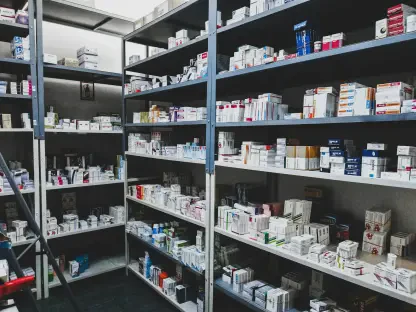The global healthcare services industry is on a transformative path, anticipated to experience significant growth from 2024 to 2030. This expansion is driven by a confluence of factors, including an aging population, technological advancements, and the increasing prevalence of chronic conditions. These dynamics are fostering growth in key market segments, such as wound care, burn care, medical disposables, and more, as the demand for innovative healthcare solutions continues to surge.
The Expanding Advanced Wound Care Market
Key Drivers of Growth
At the forefront of growth within the healthcare services market is the advanced wound care segment. Currently valued at approximately USD 10.77 billion in 2023, this market is projected to grow at a compound annual growth rate (CAGR) of 4.75% through 2030. Several factors contribute to this expansion, including an increase in chronic diseases like diabetes that require continuous monitoring and treatment. The aging population also plays a crucial role, as older individuals tend to have slower healing times, thereby necessitating more frequent and advanced wound care solutions. The heightened demand for such products reflects these underlying health trends and technological advancements that make wound care more effective and accessible.
In addition, the wound care market itself was valued at USD 22.25 billion in 2023 and is expected to experience a CAGR of 4.17% through 2030. This growth is driven by an increased number of surgical procedures worldwide, which, in turn, boosts the demand for advanced wound care products. Chronic diseases such as diabetes, often exacerbated by sedentary lifestyles, contribute significantly to the need for continuous wound care management. Innovations in wound care technologies are also playing a significant role by improving the effectiveness and user adoption of these products. As a result, this market segment remains a pivotal area within the overall healthcare services industry.
Market Dynamics and Trends
Another critical aspect driving the advanced wound care market is the continuous evolution of technology, which enhances the efficacy of wound care products. Recent advancements in materials and application methodologies have resulted in products that promote faster and more efficient healing processes. For instance, innovations in bioengineered skin substitutes and advanced dressings that maintain optimal healing conditions are increasingly being integrated into standard medical practice. These technological strides are also pushing the boundaries of what is possible in chronic wound management, offering new hope to patients and healthcare providers alike.
Moreover, the global awareness and understanding of advanced wound care’s importance in managing chronic conditions and surgical recoveries are growing. This awareness has led to increased investment in research and development, further fueling market growth. As awareness spreads, both healthcare systems and individual consumers are more willing to invest in advanced wound care products, recognizing their long-term benefits. The interplay between technological advancements and enhanced awareness ensures that the demand for advanced wound care products will continue to grow robustly, contributing significantly to the healthcare services industry’s overall expansion.
Burn Care Market on the Rise
Market Valuation and Growth Factors
The global burn care market, valued at USD 2.60 billion in 2023, is anticipated to grow at a robust CAGR of 7.18% from 2024 to 2030. This segment’s growth is primarily fueled by the rising incidence of burn injuries, which require immediate and specialized medical treatment. The increasing demand for skin grafts, essential for severe burn treatment, also drives market expansion. Alongside these factors, growing public awareness about available treatment options and continuous technological advancements in burn care significantly contribute to market growth.
Technological innovations in burn care solutions are not confined merely to products but extend to treatment methodologies, transforming how severe burns are managed. For example, introducing bioengineered skin substitutes offers a highly effective solution for treating extensive burns. These substitutes are designed to closely mimic natural skin, providing better results and quicker recovery times. Concurrently, increased funding for research and development in burn care treatments is anticipated to bring more innovative solutions to market. This combination of technology and investment is expected to sustain strong growth in the burn care market over the forthcoming years.
Technological Innovations and Treatment Advancements
Burn care advancements encapsulate a broad spectrum of innovations, ranging from revolutionary new materials to advanced medical devices that facilitate better patient outcomes. For instance, sophisticated wound dressings that release healing agents gradually over time are now being used to treat burns more effectively. Additionally, the integration of digital health solutions to monitor the healing of burn wounds remotely represents a significant leap in patient care, allowing healthcare providers to offer real-time guidance and support, thereby improving recovery outcomes.
Furthermore, technological advancements are complemented by growing initiatives focusing on public education and awareness. Programs aimed at educating the public about the importance of immediate and appropriate burn care are gaining traction, further driving the demand for innovative treatment options. These efforts are backed by healthcare providers and governments, which recognize the critical need for fast, effective burn treatment to mitigate long-term health impacts. Collectively, these advancements and initiatives are pivotal in advancing the burn care market, making it one of the fastest-growing segments within the healthcare services industry.
Rising Demand for Contrast Media and Injectors
Contrast Media Market Overview
The contrast media injectors market, valued at USD 1.19 billion in 2022, is forecasted to witness significant growth with a CAGR of 7.4% through 2030. This growth is underpinned by the increasing prevalence of chronic disorders requiring routine diagnostic imaging. Technological advancements in injector systems also contribute to market expansion by providing safer, more efficient imaging solutions. Moreover, the global rise in demand for minimally invasive surgical procedures further propels the need for advanced contrast media injectors, streamlining diagnostic processes and reducing patient recovery times.
A substantial driver of this market’s growth is the rising demand for minimally invasive diagnostic and surgical procedures. Chronic conditions such as cardiovascular diseases, cancer, and neurological disorders necessitate frequent imaging to monitor disease progression and treatment efficacy. These conditions often require sophisticated diagnostics, such as MRI and CT scans, where contrast media play a pivotal role. Technological advancements in these imaging modalities, coupled with improved contrast media formulations that enhance imaging quality, are expected to sustain the market’s robust growth trajectory.
Imaging and Diagnostic Advancements
The contrast media market itself, valued at USD 6.28 billion in 2023, expects an impressive CAGR of 7.98% from 2024 to 2030. The increasing demand for diagnostic imaging tests—including ultrasound, X-rays, MRI, and CT scans—is driven by the complexity of comorbidities and the prevalence of long-term diseases. Imaging advancements help in early detection and treatment, further enhancing the demand for contrast media. Advanced imaging techniques are becoming integral to modern medical diagnostics, offering unparalleled precision and clarity necessary for accurate diagnosis and treatment planning.
Moreover, the landscape for diagnostic imaging is continually evolving, influenced by the integration of artificial intelligence (AI) and machine learning algorithms. These technological advancements improve diagnostic accuracy and efficiency, thus increasing the utility of contrast media in various imaging applications. The growing dependence on these advanced diagnostic tools highlights the essential role of contrast media, not only in improving patient outcomes but also in optimizing healthcare operations. Consequently, the contrast media market is poised for sustained growth, reflecting broader trends in technological innovation and the increasing need for precise medical diagnostics.
Surge in First Aid Market
Market Drivers and Growth Trends
The global first aid market was valued at USD 4.64 billion in 2023 and is anticipated to grow at a CAGR of 4.57% through 2030. Several factors contribute to this growth, including an increase in the number of accidents and injuries, which necessitate immediate first aid. Additionally, there is a rising demand for first aid training and certifications among both individuals and organizations. This trend is fueled by heightened awareness about the importance of first aid in emergency situations, which can significantly impact survival and recovery outcomes.
Public and private sector initiatives to promote first aid training and accessibility are also driving market growth. Governments and health organizations are investing in campaigns to educate the public on basic first aid procedures, effectively increasing the number of trained individuals capable of providing immediate care. This heightened awareness is creating a substantial market for first aid products, ranging from simple bandages to advanced first aid kits designed for more severe injuries. The collective impact of these trends ensures a continuous and robust demand for first aid products and training, highlighting the critical role of immediate care in the healthcare continuum.
Innovations in First Aid Products
Advancements in first aid products are significantly contributing to market growth by offering more effective and user-friendly solutions. The development of innovative first aid kits that are specifically designed for various scenarios, such as home emergencies, workplace safety, or outdoor activities, ensures that individuals are better prepared to handle medical emergencies. Additionally, modern first aid kits often contain advanced medical supplies, such as saline solutions, antiseptic wipes, and burn dressings, which enhance their efficacy and broaden their application.
Efforts to improve the accessibility and affordability of first aid supplies also play a crucial role in market dynamics. Retailers and healthcare providers are working to make high-quality first aid products more widely available to the general public. This accessibility ensures that more people are equipped to handle emergencies, thereby fostering a culture of preparedness and self-reliance. As innovations continue to emerge within this market segment, the focus remains on enhancing the functionality and usability of first aid products, ensuring they meet the evolving needs of consumers.
Significant Growth in Medical Disposables Market
Market Valuation and Key Growth Factors
The medical disposables market, valued at USD 496.01 billion in 2023, is set to witness remarkable growth with a projected CAGR of 17.4% from 2024 to 2030. Several key drivers underpin this substantial growth, including the increasing incidence of Hospital Acquired Infections (HAIs), which necessitate the use of medical disposables to prevent cross-contamination. The rise in the number of surgical procedures globally, coupled with a growing geriatric population that requires prolonged hospital care, further accelerates the demand for medical disposables.
The prolonged hospital admission durations due to chronic diseases also contribute to the market’s expansion. As patients require extended care, the need for disposable medical products like gloves, masks, gowns, and other protective gear increases. Additionally, advancements in the quality and effectiveness of disposable medical products are making them indispensable in modern healthcare settings. These developments are not only improving patient care but also ensuring higher standards of hygiene and safety within healthcare facilities, thereby driving robust growth in the medical disposables market.
Addressing Infection Control and Demand Surge
Infection control protocols are crucial in healthcare, and the surge in Hospital Acquired Infections (HAIs) significantly underscores the need for medical disposables. These infections, often contracted during hospital stays, can have severe implications for patient health and recovery. The heightened focus on infection control measures, especially amidst the COVID-19 pandemic, has made the use of disposable medical products even more critical. As a result, the market has seen higher demand for disposable items to prevent the spread of HAIs and ensure better patient outcomes.
Moreover, the innovations within the disposable medical products sector are addressing specific healthcare challenges more effectively. For example, the development of antimicrobial disposable products is providing an additional layer of protection against infection. These products are designed to reduce the risk of contamination and are being increasingly adopted in hospitals and clinics worldwide. Such innovations, along with stringent regulatory requirements for infection control, are propelling the medical disposables market forward, ensuring that healthcare providers have access to the best possible tools for maintaining hygiene and patient safety.
Expanding Sterilization Equipment Market
Market Dynamics and Growth
The global sterilization equipment market, valued at USD 7.0 billion in 2022, is projected to grow at a robust CAGR of 10.6% through 2030. This growth is largely attributed to the increasing prevalence of Hospital Acquired Infections (HAIs), especially among patients undergoing long-term surgical treatments. The need for sterilization equipment is paramount in ensuring that surgical instruments and medical devices are free from harmful pathogens. This essential role in infection prevention makes sterilization equipment a critical component of modern healthcare.
Sterilization equipment covers a wide range of products, including autoclaves, low-temperature sterilizers, and chemical sterilizers, each playing an essential part in maintaining hospital hygiene standards. The rising awareness about the importance of proper sterilization in preventing HAIs is driving demand across healthcare facilities globally. Additionally, as healthcare providers strive to meet stringent regulatory guidelines, the adoption of advanced sterilization technologies is becoming increasingly prevalent. This ensures that patient safety and infection control measures are effectively upheld.
Innovations and Technological Advancements
Technological advancements in sterilization equipment are significantly enhancing the efficiency and effectiveness of these crucial healthcare tools. For instance, the development of automated and portable sterilizers offers substantial improvements in ease of use and accessibility. These innovations ensure that healthcare providers can maintain high sterilization standards across various settings, from large hospitals to smaller clinics. The integration of digital monitoring systems is another advancement, providing real-time data on sterilization processes and ensuring compliance with regulatory standards.
Moreover, the continuous evolution of sterilization technologies is addressing some of the significant challenges in infection control. The introduction of low-temperature sterilization methods, suitable for heat-sensitive instruments, is broadening the scope of effective sterilization. These advancements not only improve patient safety but also enhance the operational efficiency of healthcare facilities. As the market continues to innovate, the focus remains on developing more sophisticated and user-friendly sterilization solutions, ensuring that healthcare providers have the best possible tools for maintaining hygiene and safety standards.
Conclusion
The global healthcare services industry is poised for remarkable growth from 2024 to 2030, undergoing a transformative phase driven by several key factors. An aging population is a significant contributor, as older individuals typically require more medical attention and services. Concurrently, technological advancements are revolutionizing the sector, bringing forth innovative solutions that enhance patient care and streamline medical processes. Additionally, chronic conditions are becoming increasingly common, necessitating advanced and continuous healthcare management. These elements combined are fueling a surge in demand across various market segments, including wound care, burn care, and medical disposables. Moreover, the industry’s expansion is also supported by a growing awareness of health and wellness among consumers, who are now more proactive in seeking medical advice and preventive treatments. This heightened demand for innovative healthcare solutions underscores the industry’s transformative journey, promising substantial growth and improvements in the quality and accessibility of healthcare services worldwide.









